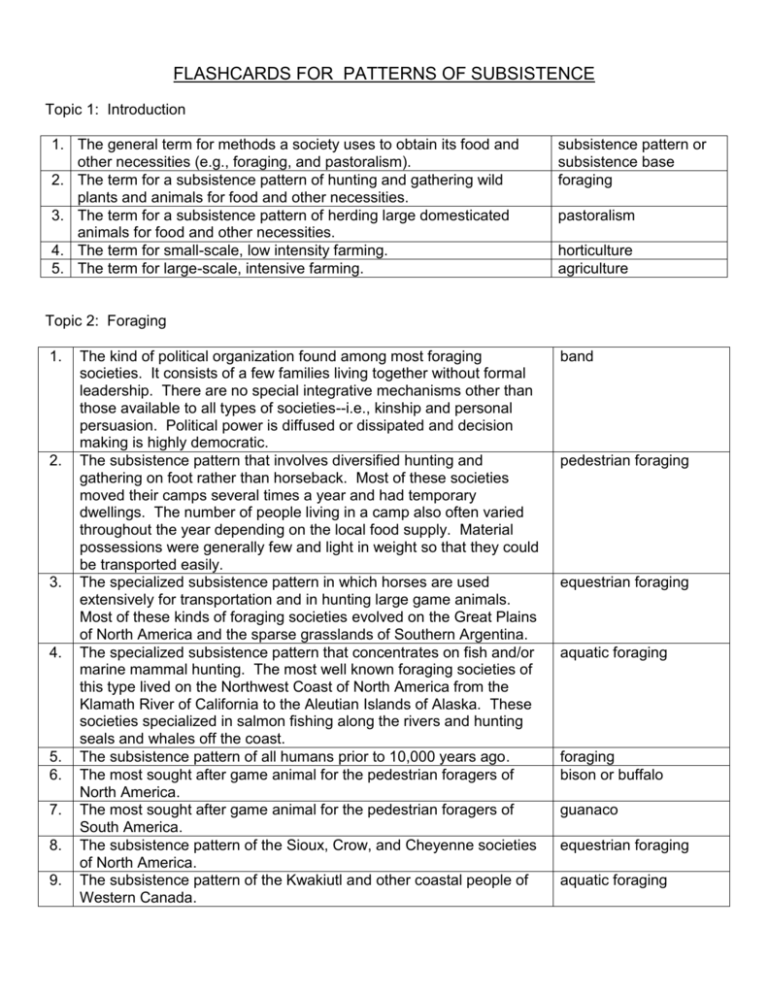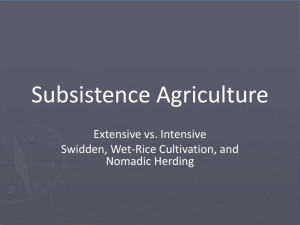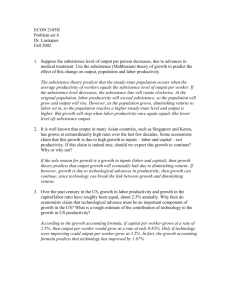
FLASHCARDS FOR PATTERNS OF SUBSISTENCE
Topic 1: Introduction
1. The general term for methods a society uses to obtain its food and
other necessities (e.g., foraging, and pastoralism).
2. The term for a subsistence pattern of hunting and gathering wild
plants and animals for food and other necessities.
3. The term for a subsistence pattern of herding large domesticated
animals for food and other necessities.
4. The term for small-scale, low intensity farming.
5. The term for large-scale, intensive farming.
subsistence pattern or
subsistence base
foraging
pastoralism
horticulture
agriculture
Topic 2: Foraging
1.
2.
3.
4.
5.
6.
7.
8.
9.
The kind of political organization found among most foraging
societies. It consists of a few families living together without formal
leadership. There are no special integrative mechanisms other than
those available to all types of societies--i.e., kinship and personal
persuasion. Political power is diffused or dissipated and decision
making is highly democratic.
The subsistence pattern that involves diversified hunting and
gathering on foot rather than horseback. Most of these societies
moved their camps several times a year and had temporary
dwellings. The number of people living in a camp also often varied
throughout the year depending on the local food supply. Material
possessions were generally few and light in weight so that they could
be transported easily.
The specialized subsistence pattern in which horses are used
extensively for transportation and in hunting large game animals.
Most of these kinds of foraging societies evolved on the Great Plains
of North America and the sparse grasslands of Southern Argentina.
The specialized subsistence pattern that concentrates on fish and/or
marine mammal hunting. The most well known foraging societies of
this type lived on the Northwest Coast of North America from the
Klamath River of California to the Aleutian Islands of Alaska. These
societies specialized in salmon fishing along the rivers and hunting
seals and whales off the coast.
The subsistence pattern of all humans prior to 10,000 years ago.
The most sought after game animal for the pedestrian foragers of
North America.
The most sought after game animal for the pedestrian foragers of
South America.
The subsistence pattern of the Sioux, Crow, and Cheyenne societies
of North America.
The subsistence pattern of the Kwakiutl and other coastal people of
Western Canada.
band
pedestrian foraging
equestrian foraging
aquatic foraging
foraging
bison or buffalo
guanaco
equestrian foraging
aquatic foraging
10. Where most of the !Kung or Dobe Ju/'hoansi people live.
11. Another term for foraging.
Kalahari Desert in
Namibia and Botswana
hunting and gathering
Topic 3: Pastoralism
1.
2.
3.
4.
5.
6.
7.
8.
9.
The kind of animal that is predominantly herded by pastoralists in
East Africa.
The kind of animal that is predominantly herded by in northern
Scandinavia.
The preferred kind of animal for herding among most pastoralists in
Central Asia.
The term for the kind of pastoralism in which people follow a seasonal
migratory pattern that can vary from year to year. The timing and
destinations of migrations are determined primarily by the needs of
the herd animals for water and fodder. These societies do not create
permanent settlements, but rather they live in tents or other relatively
easily constructed dwellings the year round.
The term for the kind of pastoralism in which people follow a cyclical
pattern of migrations, usually moving their animals to cool highland
valleys in the summer and warmer lowland valleys in the winter. This
is seasonal migration between the same two locations in which they
have regular encampments or stable villages often with permanent
houses.
The kind of region in which pastoralism is the optimal subsistence
pattern when the technological level is low.
The kind of kinship pattern that is most common for pastoralist
societies. (Hint: this descent pattern is one in which family ties are
followed through the male line only.)
The most important criterion on which the division of labor in
pastoralist societies is based.
The personality traits for pastoralist men throughout the world that are
encouraged and respected by their societies.
10. How men in pastoralist societies usually acquire prestige and power.
11. The common marriage pattern for successful pastoralist men in East
Africa.
12. The food source for all herd animals kept by pastoralists around the
world.
cattle
reindeer
horse
pastoral nomadism
transhumance
semi-arid open country
in which farming can not
be easily sustained
patrilineal descent
gender (male or female)
cooperative with each
other but aggressive
towards outsiders;
realistic with an attitude
of self-containment,
personal control, and
bravery
being a brave and
successful leader of
men as well as by
accumulating large
herds of animals
polygyny (one man and
several wives)
plants (usually grasses)
13.
14.
15.
16.
17.
Where the Zulus live.
Where the Masai and Kikuyu live.
Where the Saami (or Lapps) live.
Where the Mongols live.
Pastoralists who conquered China and Central Asia in the 13th
century A.D. as well as much of Russia and the Middle East in the
14th century.
18. Pastoralists who began an intermittent war with the Dutch settlers of
South Africa (i.e., the Boers) after defeating several African farming
peoples. They were finally subdued with great difficulty by the British
army in 1879.
19. What most national governments tried to do with the pastoralists in
their territories during the 20th century.
20. A term that refers to how jobs are divided up within the family and
society.
South Africa
East Africa
northern Scandinavia
Central Asia (Mongolia)
Mongols
Zulus
force them to stop their
migrations in order to
control them and reduce
the size of their herds in
order to prevent overgrazing
division of labor
Topic 4: Horticulture
1.
2.
3.
4.
5.
6.
The kind of environmental zone in which horticulture is still practiced
today.
The method commonly used by horticulturalists to clear fields of
heavy vegetation in preparation for planting new crops. With this
method, brush and small trees are cut down and allowed to dry out in
place. They are then burned.
Why Mesoamerican horticulturalists plant corn, bean, and squash
seeds in the same hole.
Where the nutrients for plant growth are mostly located in tropical
forests.
What happens to a tropical forests nutrients and its soil when forestry
product corporations cut down most of the trees and haul them off for
lumber.
What horticulturalists do when the nutrients have become depleted in
their farm plot and the weeds and insects pests are too much
competition for their crops.
mostly in tropical forests
slash and burn
the corn stalk provides
support for the climbing
bean plant and the
squash grows over the
ground and keeps down
the weeds
in growing plants rather
than the soil
most of the nutrients are
permanently removed
leaving the soil
impoverished and then
rainfall erodes it away
leaving a waste land
abandon the plot and
start a new one in an
area that has not been
farmed for many years if
at all
7.
8.
The typical kind of farming equipment used by horticulturalists to plant
and tend their crops.
The horticultural practice of abandoning a farm plot and creating
another when crop production drops due to the inevitable depletion of
soil nutrients. This is also referred to as "swidden cultivation."
digging stick and/or hoe
shifting agriculture
Topic 5: Intensive Agriculture
1.
2.
3.
4.
5.
6.
7.
The subsistence pattern that usually produces the most food per acre
of land.
How many years ago the development of intensive farming methods
became necessary as the human population grew in some major river
valleys to levels beyond the carrying capacity of the environment
using horticulture and pastoralism.
The major innovations that made the original transition of intensive
agriculture possible.
intensive agriculture
5,000
water management
systems (e.g., irrigation)
and the domestication
of large animals for
pulling plows
Where the first successful intensive agricultural societies were
river valleys in Egypt,
located. (Hint: these were the early civilizations.)
Mesopotamia (now Iraq
and part of Syria), India,
North China,
Mesoamerica, and
Western South America
What happened to the social classes as the ancient civilizations
they became rigidly
developed.
divided with power and
wealth monopolized by
a few people at the top
What happened to the concept of property ownership as the ancient
the concept of
civilizations developed.
individuals being merely
stewards of land for the
community was
replaced by the concept
of individuals having
absolute personal
property rights
The term for intensive farming for the production of cereals (e.g., corn, mechanized grain
wheat, oats) in which hundreds and even thousands of acres are
farming
planted, tended, and harvested by a small number of people using
large machinery (e.g., tractors and combines). There usually are
heavy applications of fertilizers, pesticides, and herbicides. This
highly productive form of intensive mono-cropping agriculture is
capital but not labor intensive.
8.
The term for farming based on large labor-intensive farms that mostly
produces fruit, sugar, fiber, or vegetable oil products for the
international market. The laborers usually work for very low wages
that keep them in poverty. Many of these large farms in Indonesia,
the Philippines, Central America, the Caribbean, and West Africa are
owned by multinational corporations such as Dole and the National
Fruit Company. The net effect of this form of agriculture generally has
been the flow of wealth from poor nations in the Southern Hemisphere
to rich ones in the Northern Hemisphere.
9. A subsistence pattern characterized by full-time farming in which large
beasts of burden or highly mechanized farm equipment (e.g.,
rototillers and tractors) are used to prepare the land for planting.
There usually is irrigation or other forms of water management. Often
there is mono-cropping with heavy applications of fertilizers,
pesticides, and herbicides. This form of farming is highly productive
but generally capital intensive.
10. A term for planting a crop of only one species in a farm field.
11. A term for planting a farm field with more than one species of plant.
plantation agriculture
intensive agriculture
mono-cropping
multi-cropping
Topic 6: Comparisons
1.
The subsistence pattern that is least likely to result in a modification of
the environment to increase the production of food.
2. The subsistence pattern that is most likely to result in a modification
of the environment to increase the production of food.
3. The subsistence pattern that is most likely to result in societies that
are egalitarian for most people.
4. The subsistence pattern that is least likely to result in societies that
are egalitarian for most people. (Hint: egalitarian means equal in
terms of economic and political rights.)
5. The subsistence pattern that usually requires the highest percentage
of people in a society to be involved in subsistence activities.
6. The subsistence pattern that usually requires the lowest percentage
of people in a society to be involved in subsistence activities.
7. The subsistence pattern that usually results in the highest human
population density.
8. The subsistence pattern that usually results in the lowest human
population density.
9. The subsistence pattern that is used by societies that have the most
devastating epidemics of contagious diseases in terms of the
percentage of people in a society who are affected.
10. The subsistence pattern that is used by societies that are most likely
to undertake large-scale, prolonged warfare against other societies.
11. A term that means equal in terms of economic and political rights.
Copyright © 2007 by Dennis O'Neil. All rights reserved.
foraging
intensive agriculture
foraging
intensive agriculture
foraging
intensive agriculture
intensive agriculture
foraging
intensive agriculture
intensive agriculture
egalitarian






